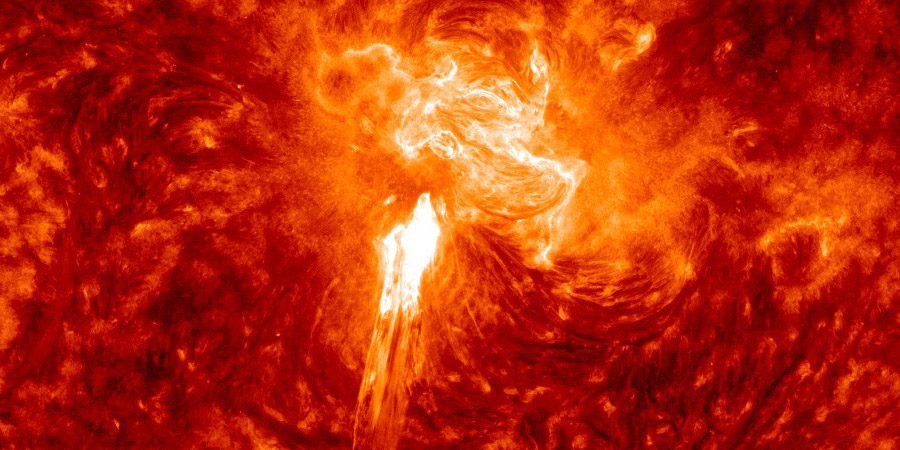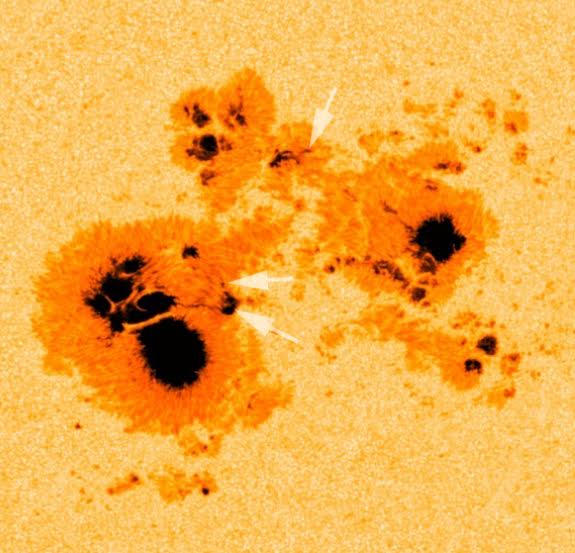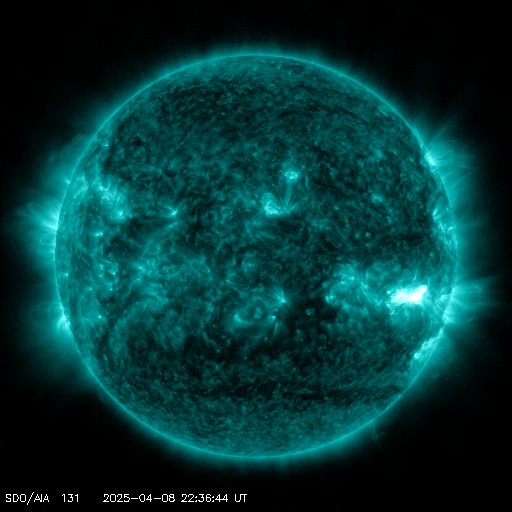Sunspot region 2192, eruptive M4 solar flare
Friday, 24 October 2014 20:02 UTC

Another relatively quiet day when you consider the size of sunspot region 2192, the largest sunspot region that faced Earth in 24 years! Solar activity has been moderate today with only one M-class solar flare: M4.07 (R1-minor) at 07:48 UTC. This solar flare was rather impulsive but it was eruptive for a change and it did produce a coronal mass ejection! The bad news is that sunspot region 2192 miraculously managed to send the eruption south of the Sun-Earth line. No impact at Earth is thus expected from this event. In this article we take a closer look at the M4.0 solar flare and the evolution of sunspot region 2192.
The image below shows the coronal mass ejection that was released following the M4 solar flare as seen by SOHO. As you can see, all of the ejecta is heading well south of the Sun-Earth line. The video above from SDO shows the M4 solar flare and the eruption that it created.

NOAA SWPC alerts
ALERT: Type IV Radio Emission Begin Time: 2014 Oct 24 0759 UTC
ALERT: Type II Radio Emission Begin Time: 2014 Oct 24 0755 UTC Estimated Velocity: 664 km/s
Evolution of sunspot region 2192
Sunspot region 2192 continues to decay further, especially in the central part where the penumbral area vanishes at a fast speed. The western and northern part of the sunspot cluster continue to drift away from the main polarity zone creating a big gap between it. Enough of the bad news, there is also something positive to tell. The delta spot near the main leader spot (just west of it) continues to grow and strengthen. A small dark line of positive polarity umbra stretches out onto the delta spot with negative polarity. This is a good development that keeps the region magnetically complex and should be good for further M-class flares and a slight chance for an X-class event.

All the other sunspot regions on the disk are unremarkable. Any future solar flares will very likely be centered around sunspot region 2192 which is now directly facing Earth. A strong eruption from sunspot region 2192 could cause a solar radiation storm.
Solar flare odds for the coming 24 hours
M-class flare probability: 60% chance
X-class flare probability: 10% chance
Images and video: NASA SDO, ESA/NASA SOHO.
Thank you for reading this article! Did you have any trouble with the technical terms used in this article? Our help section is the place to be where you can find in-depth articles, a FAQ and a list with common abbreviations. Still puzzled? Just post on our forum where we will help you the best we can!
Current data suggests there is a slight possibility for aurora to appear at the following high latitude regions in the near future
Gillam, MB, Iqaluit, NUNuuk
Reykjavik
Latest news
Latest forum messages
Support SpaceWeatherLive.com!
A lot of people come to SpaceWeatherLive to follow the Sun's activity or if there is aurora to be seen, but with more traffic comes higher server costs. Consider a donation if you enjoy SpaceWeatherLive so we can keep the website online!

Latest alerts
01:45 UTC - Geomagnetic activity
Active geomagnetic conditions (Kp4) Threshold Reached: 01:41 UTC
Wednesday, 9 April 2025
08:12 UTC - Hemispheric Power Index
The OVATION model predicts the Hemispheric Power Index to reach 76GW at 08:57 UTC
02:00 UTC - Geomagnetic activity
Minor G1 geomagnetic storm (Kp5) Threshold Reached: 01:45 UTC
Tuesday, 8 April 2025
23:57 UTC - Hemispheric Power Index
The OVATION model predicts the Hemispheric Power Index to reach 50GW at 00:44 UTC
22:42 UTC - Solar flare
Moderate M1.57 flare
Space weather facts
| Last X-flare | 2025/03/28 | X1.1 |
| Last M-flare | 2025/04/08 | M1.5 |
| Last geomagnetic storm | 2025/04/06 | Kp5 (G1) |
| Spotless days | |
|---|---|
| Last spotless day | 2022/06/08 |
| Monthly mean Sunspot Number | |
|---|---|
| March 2025 | 134.2 -20.4 |
| April 2025 | 148.6 +14.4 |
| Last 30 days | 139.3 +3.1 |





